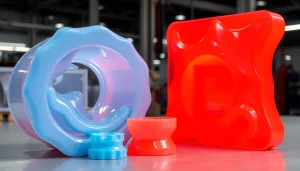Leading Blow Molding Machine Supplier: Advancing Your Production Efficiency

Understanding Blow Molding Technology
What is Blow Molding?
Blow molding is a manufacturing process used to create hollow plastic parts. It involves inflating a molten plastic tube, known as a parison, within a mold to form a desired shape. This method is particularly effective for creating bottles, containers, and various hollow items with specific geometric shapes. The blow molding process has become an essential part of modern manufacturing, offering flexibility and efficiency in production.
Types of Blow Molding Processes
There are three primary types of blow molding processes, each suited for specific applications:
- Extrusion Blow Molding (EBM): This technique involves extruding a heated plastic tube and then enclosing it in a mold to shape it using high pressure air. It’s ideal for producing large containers and bottles with uniform wall thickness.
- Injection Blow Molding (IBM): In this process, a preformed parison is created using injection molding, and then air is blown into this core to form the final shape. This method is known for producing bottles with a superior finish and better clarity.
- Stretch Blow Molding: This method stretches and then blows the preform into a mold, allowing for thinner walls and enhanced strength characteristics, particularly ideal for PET bottles used in the beverage industry.
Applications of Blow Molding Machines
Blow molding machines are widely used across various industries. Some primary applications include:
- Beverage Bottles: Popular in the soft drink industry, PET bottles produced through blow molding are lightweight and can be mass-produced efficiently.
- Containers: Cosmetic and pharmaceutical industries utilize blow-molded containers for creams, gels, and medicines due to their hygienic properties and customizable designs.
- Toys and Sporting Goods: Various molded plastic toys and sporting goods benefit from the versatility of blow molding processes.
Key Features of Modern Blow Molding Machines
Efficiency Improvements in Production
Today’s blow molding machines boast several advancements that enhance production efficiency: rapid changeover capabilities, integrated automation, and enhanced cooling systems reduce cycle times significantly.
Common Materials Used
Blow molding primarily utilizes thermoplastics, with polyethylene (PE) and polyethylene terephthalate (PET) being the most common materials. Other materials may include polystyrene and polyvinyl chloride based on specific application needs, like flexibility or clarity.
Technological Innovations in Blow Molding
The blow molding industry has seen numerous technological innovations, such as:
- Smart Technology: Integration of IoT devices allows for real-time monitoring and control, enhancing operational efficiency and reducing maintenance costs.
- Eco-Friendly Options: Many manufacturers are now offering machines designed to use bio-based and recycled materials, contributing to sustainable practices.
- Energy Efficient Designs: New machines consume significantly less energy while increasing production speeds, helping reduce overall operational costs.
Choosing the Right Blow Molding Machine Supplier
Evaluating Supplier Reputation and Experience
When considering a blow molding machine supplier, it’s crucial to assess their reputation in the industry. Look for suppliers with a proven track record, positive customer testimonials, and extensive industry experience. A respected supplier often provides more reliable products and better after-sales support, which is essential for maintaining operational efficiency.
Identifying Your Production Needs
Your production needs are crucial in selecting the appropriate blow molding machine. Assess factors like production volume, part dimensions, material type, and expected production rate. By clearly defining these parameters, you can better match your needs with the capabilities of various blow molding machine suppliers, ensuring optimal performance and cost-effectiveness.
Comparing Prices and Product Offers
Price comparison is vital, but it is equally essential to evaluate the total cost of ownership, which includes maintenance, parts, energy consumption, and potential downtime costs. Engage with suppliers to understand their product offerings, and make sure to assess warranty options and service agreements to get the best long-term value.
Cost Considerations in Blow Molding
Initial Investment and Ongoing Costs
The initial cost of blow molding machines can vary significantly based on the machine’s complexity and capabilities. While EBM machines might start around $30,000, high-capacity machines can range considerably higher. Understanding ongoing costs, such as energy, maintenance, and materials, is just as important for budgeting long-term investment.
Factors Influencing Machine Pricing
Several factors influence the pricing of blow molding machines:
- Machine Type: Different types of blow molding machines will certainly have varying costs based on their design and functionality.
- Automation Level: Fully automated machines are typically more expensive upfront, but they can reduce labor costs significantly and enhance production rates.
- Customization: Custom-built machines tailored to specific production requirements can also come with a higher price tag but may deliver superior performance and longevity.
Long-Term Value of Quality Suppliers
Investing in machinery from a reputable blow molding machine supplier can yield superior long-term value. Quality machines are less likely to break down, require less maintenance, and contribute to a more efficient operation. Suppliers who provide good after-sales support can assist with training, repairs, and part replacements, further enhancing the machine’s productive life.
Global Trends in Blow Molding Industry
Market Growth and Demand Analysis
The blow molding market has been undergoing rapid growth, driven by increasing demand for plastic packaging and a rising emphasis on product design and functionality. The anticipated growth in the beverage and cosmetic sectors significantly influences this trend, with suppliers seeking efficient production methods.
Environmental Considerations and Innovations
As manufacturers globally strive to align with sustainability goals, the blow molding industry has introduced eco-friendly materials and processes. This has led to innovations such as machines that can handle recycled materials, drastically reducing waste. Additionally, companies increasingly focus on energy-efficient production to decrease their carbon footprint.
The Future of Blow Molding Technology
The future of blow molding technology appears bright, with continuous advancements expected in materials, automation, and efficiency. The integration of AI and machine learning may revolutionize production processes, enabling predictive maintenance and real-time monitoring for even greater efficiency.
For businesses seeking to enhance their production capabilities, aligning with a reliable Blow Molding Machine Supplier can provide integral support in navigating these advancements, ensuring they’re equipped to meet evolving market demands.






